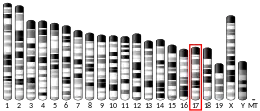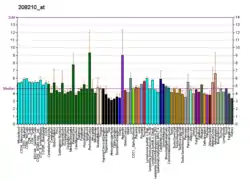MAS proto-oncogene, or MAS1 proto-oncogene, G protein-coupled receptor (MRGA, MAS, MGRA""), is a protein that in humans is encoded by the MAS1 gene.[5] The structure of the MAS1 product indicates that it belongs to the class of receptors that are coupled to GTP-binding proteins and share a conserved structural motif, which is described as a '7-transmembrane segment' following the prediction that these hydrophobic segments form membrane-spanning alpha-helices. The MAS1 protein may be a receptor that, when activated, modulates a critical component in a growth-regulating pathway to bring about oncogenic effects.[5]
Agonists of the receptor include angiotensin-(1-7). Antagonist include A-779 (angiotensin-1-7 with c-terminal proline substituted for D-Ala), or D-Pro (angiotensin-1-7 with c-terminal proline submitted for D-proline).
Mas1 proto-oncogene (MAS1, MGRA) is not to be confused with the MAS-related G-protein coupled receptor, a recently believed to be activated by the ligand alamandine (generated by catalysis of Ang A via ACE2 or directly from Ang-(1-7)).
See also
References
- 1 2 3 GRCh38: Ensembl release 89: ENSG00000130368 - Ensembl, May 2017
- 1 2 3 GRCm38: Ensembl release 89: ENSMUSG00000068037 - Ensembl, May 2017
- ↑ "Human PubMed Reference:". National Center for Biotechnology Information, U.S. National Library of Medicine.
- ↑ "Mouse PubMed Reference:". National Center for Biotechnology Information, U.S. National Library of Medicine.
- 1 2 "Entrez Gene: MAS1 MAS1 oncogene".
Further reading
- Hanley MR (1992). "Molecular and cell biology of angiotensin receptors". Journal of Cardiovascular Pharmacology. 18 (Suppl 2): S7-13. doi:10.1097/00005344-199106182-00003. PMID 1725048.
- Hanley MR, Cheung WT, Hawkins P, Poyner D, Benton HP, Blair L, Jackson TR, Goedert M (1990). "The mas Oncogene as a Neural Peptide Receptor: Expression, Regulation and Mechanism of Action". Ciba Foundation Symposium 150 ‐ Proto‐Oncogenes in Cell Development. Novartis Foundation Symposia. Vol. 150. pp. 23–38, discussion 38–46. doi:10.1002/9780470513927.ch3. ISBN 9780470513927. PMID 2197067.
{{cite book}}:|journal=ignored (help) - Rabin M, Birnbaum D, Young D, Birchmeier C, Wigler M, Ruddle FH (Jul 1987). "Human ros1 and mas1 oncogenes located in regions of chromosome 6 associated with tumor-specific rearrangements". Oncogene Research. 1 (2): 169–78. PMID 3329713.
- Jackson TR, Blair LA, Marshall J, Goedert M, Hanley MR (Sep 1988). "The mas oncogene encodes an angiotensin receptor". Nature. 335 (6189): 437–40. Bibcode:1988Natur.335..437J. doi:10.1038/335437a0. PMID 3419518. S2CID 4360847.
- Young D, Waitches G, Birchmeier C, Fasano O, Wigler M (Jun 1986). "Isolation and characterization of a new cellular oncogene encoding a protein with multiple potential transmembrane domains". Cell. 45 (5): 711–9. doi:10.1016/0092-8674(86)90785-3. PMID 3708691. S2CID 29886272.
- Riesewijk AM, Schepens MT, Mariman EM, Ropers HH, Kalscheuer VM (Jul 1996). "The MAS proto-oncogene is not imprinted in humans". Genomics. 35 (2): 380–2. doi:10.1006/geno.1996.0372. PMID 8661154.
- Xu X, Quiambao AB, Roveri L, Pardue MT, Marx JL, Röhlich P, Peachey NS, Al-Ubaidi MR (May 2000). "Degeneration of cone photoreceptors induced by expression of the Mas1 protooncogene". Experimental Neurology. 163 (1): 207–19. doi:10.1006/exnr.2000.7370. PMID 10785460. S2CID 24445328.
- Alenina N, Baranova T, Smirnow E, Bader M, Lippoldt A, Patkin E, Walther T (May 2002). "Cell type-specific expression of the Mas proto-oncogene in testis". The Journal of Histochemistry and Cytochemistry. 50 (5): 691–6. doi:10.1177/002215540205000510. PMID 11967280. S2CID 44690751.
- Santos RA, Simoes e Silva AC, Maric C, Silva DM, Machado RP, de Buhr I, Heringer-Walther S, Pinheiro SV, Lopes MT, Bader M, Mendes EP, Lemos VS, Campagnole-Santos MJ, Schultheiss HP, Speth R, Walther T (Jul 2003). "Angiotensin-(1-7) is an endogenous ligand for the G protein-coupled receptor Mas". Proceedings of the National Academy of Sciences of the United States of America. 100 (14): 8258–63. Bibcode:2003PNAS..100.8258S. doi:10.1073/pnas.1432869100. PMC 166216. PMID 12829792.
- Canals M, Jenkins L, Kellett E, Milligan G (Jun 2006). "Up-regulation of the angiotensin II type 1 receptor by the MAS proto-oncogene is due to constitutive activation of Gq/G11 by MAS". The Journal of Biological Chemistry. 281 (24): 16757–67. doi:10.1074/jbc.M601121200. PMID 16611642.
This article incorporates text from the United States National Library of Medicine, which is in the public domain.




